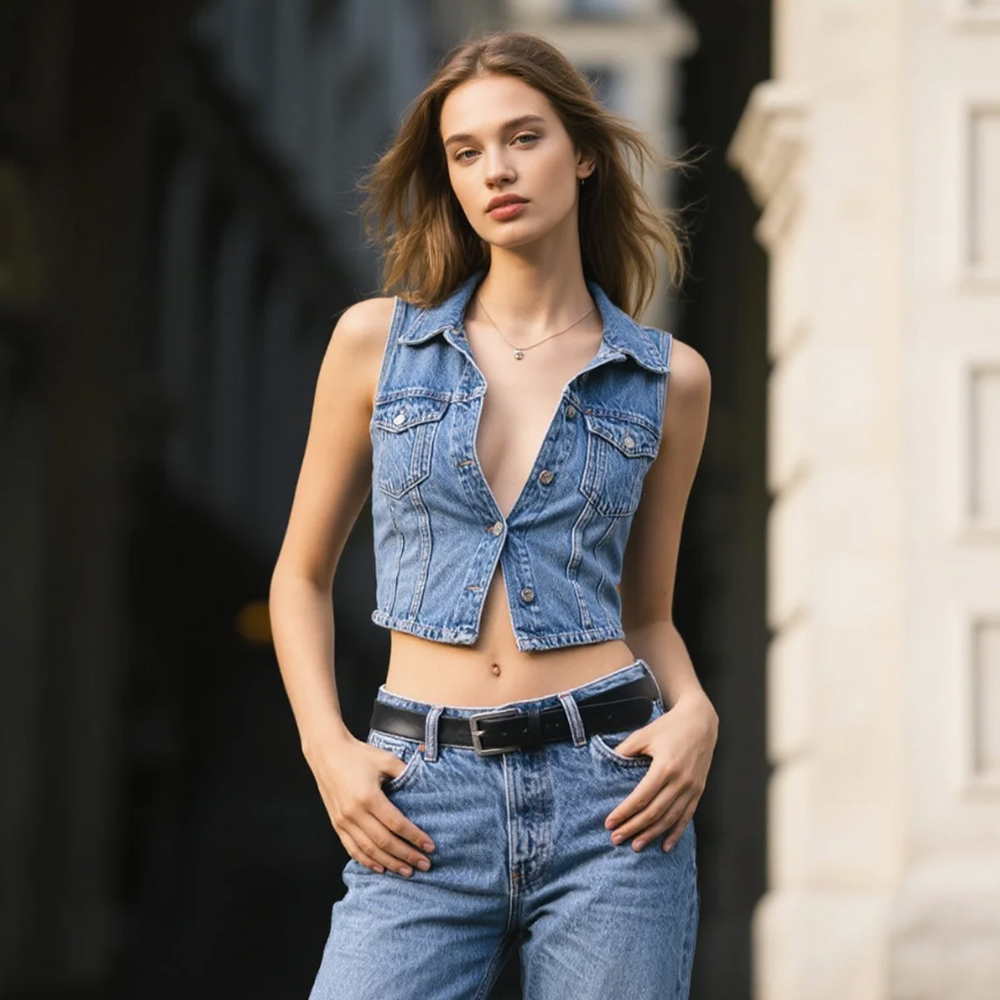Denim isn’t just fabric—it’s a global language of style, durability, and identity. From classic blue jeans to trendy denim jackets and coordinated sets, the global denim market is projected to hit $105 billion by 2030, driven by Gen Z’s love for retro revivals and eco-conscious shoppers demanding sustainability. As someone who’s navigated the ins and outs of exporting denim sets—from sleek office-ready pairs to rugged weekend wear—here’s my no-nonsense guide to turning this staple into a thriving export business.

Step 1: Decode the Market—Denim Tastes Vary by Region (and Generation)
Denim preferences are far from one-size-fits-all. Understanding regional nuances is key to avoiding “great product, wrong market” pitfalls.
- Europe & North America: These markets crave heritage and authenticity. Think high-quality selvedge denim (raw, unwashed edges), vintage-inspired washes (acid wash, stone wash), and versatile fits (slim, straight, or relaxed). Sustainability is a top priority here—consumers will pay more for GOTS-certified organic cotton or recycled denim (e.g., Levi’s Water<Less collection).
- Southeast Asia & Middle East: Brighter colors (pastel pinks, sky blues), lighter weights (8-10 oz denim for tropical climates), and bold details (embroidery, patchwork) dominate. Demand spikes around Eid, Diwali, and summer festivals—think “denim kurta” hybrids for Indian markets or cropped denim skirts for beachgoers.
- Japan & South Korea: Precision is everything. Shoppers favor tailored fits (slim-tapered waists, narrow legs) and minimalist designs—think monochrome sets with hidden pockets or subtle distressing. K-pop idols and J-fashion trends heavily influence what sells (e.g., oversized denim jackets paired with cropped skinny jeans).
Step 2: Design for Versatility—Denim Sets That “Grow” with Buyers
The best denim sets aren’t just pants and a top—they’re wardrobe multitaskers. A set that works for a coffee run, a concert, and a weekend hike? That’s a customer magnet.
- Functional Features:
- Adjustable Elements: Elastic waistbands, drawstrings, or removable belts cater to different body types (a game-changer for plus-size markets).
- Multi-Pocket Utility: Cargo pockets on jackets, coin purses on skirts, or hidden phone slots in pants add practicality (popular with Gen Z for “effortlessly cool” daily use).
- Color Coordination: Offer “mix-and-match” sets—e.g., a classic indigo jacket with black skinny jeans, or a white denim top with distressed white pants for a monochromatic look.
- Trend Integration:
Track micro-trends via platforms like Pinterest or TikTok. For 2024, expect:- Y2K Revival: Low-rise jeans, bedazzled belts, and transparent vinyl accents.
- Eco-Chic: Upcycled denim (made from recycled plastic bottles) or “patchwork” sets combining vintage and new fabric.
Step 3: Master the Supply Chain—Quality Control is Non-Negotiable
In denim exports, consistency is everything. A single faded wash or uneven seam can tank a retailer’s trust (and your reputation).
- Fabric Sourcing: Start with trusted mills. For premium sets, use 100% cotton selvedge denim from Italy or Turkey (soft yet durable). For budget-friendly lines, consider cotton-poly blends (e.g., 70% cotton, 30% polyester) that resist shrinking and wrinkling. Test samples for:
- Colorfastness: Wash denim 5+ times to ensure dyes don’t bleed.
- Stitch Integrity: Reinforce stress points (knees, pockets, zippers) with double-stitched seams.
- Sizing Precision: Avoid “vanity sizing”—provide detailed size charts (waist, hip, inseam) with measurements in inches/cm. For Asian markets, note that a “M” might fit smaller than US/EU sizes—include a “size guide” video to reduce returns.
- Production Partners: Work with factories that specialize in denim sets. Small orders? Partner with Vietnamese or Bangladeshi manufacturers (lead times 30-45 days). For bulk orders, Turkish or Portuguese factories offer tighter quality control (60-90 days). Inspect pre-production samples personally—don’t rely on photos alone.
Step 4: Compliance & Certifications—Avoid Customs Headaches
Denim is subject to strict global regulations. Miss one, and your shipment could be delayed (or worse, destroyed).
- Labeling Requirements: Every garment needs:
- Fiber content (e.g., “98% Cotton, 2% Spandex”).
- Care instructions (machine wash cold, tumble dry low).
- Country of origin (“Made in Bangladesh” or “Manufactured in Portugal”).
- For the EU: REACH compliance (no restricted chemicals like formaldehyde).
- For the US: CPSIA (if targeting kids’ sizes, though most denim sets are adult-focused).
- Sustainability Claims: If marketing “eco-friendly” denim, back it up with certifications like GOTS (Global Organic Textile Standard) or BCI (Better Cotton Initiative). Misleading claims can lead to fines or brand damage.
Step 5: Market with Storytelling—Sell the Lifestyle, Not Just the Product
Consumers don’t buy denim sets—they buy confidence. Your marketing should reflect that.
- Social Media Magic: Use Instagram Reels to film models styling the same set in 3 ways: casual (with sneakers), dressed up (with ankle boots), or edgy (with a leather jacket). Partner with micro-influencers (10k-50k followers) for unboxing videos—“I’ve never loved a denim set this much!”
- Retailer Support: Provide high-quality lookbooks with lifestyle shots (e.g., a couple dancing at a music festival, friends hiking in the mountains). For B2B clients, send “style guides” with pairing tips (“Pair our cropped jacket with high-waisted jeans for a 90s throwback”).
- Emotional Packaging: Add a handwritten note or a small denim patch (for DIY repairs) to every order. Retailers love including these to upsell—“Not just denim—memories in every stitch.”
Red Flags to Avoid
- Ignoring Feedback: If a retailer says, “The wash is too dark for our market,” adjust your dye process—don’t stick to your initial recipe.
- Overcomplicating Designs: A simple, well-fitted set often outsells overly decorated ones.
- Skipping Samples: Always send physical samples before bulk production. What looks good on a screen might feel cheap in person.
Final Thoughts: Denim is Timeless—Your Export Game Should Be Too
Exporting denim sets isn’t just about selling fabric—it’s about delivering confidence, durability, and style. With the right mix of market insight, supply chain rigor, and storytelling, you can turn this classic staple into a global bestseller.
At Sheen Apparel Solutions, we’ve spent 15 years mastering the art of denim exports. Our factories in Turkey and Vietnam specialize in premium selvedge denim, sustainable blends, and trend-driven designs. Whether you’re a startup retailer or an established brand, we offer:
- Custom design support (from wash development to final stitching).
- Flexible MOQs (start with 500 pieces, scale as you grow).
- End-to-end logistics (FOB, CIF, or DDP options).
Ready to make your mark in the global denim market? Follow our blog for deep dives into fabric trends, retailer negotiation hacks, and behind-the-scenes looks at our design process. Have questions about certifications, lead times, or custom orders? Reach out—we’re here to help you turn denim dreams into thriving export businesses.
Because when it comes to denim, the best sets aren’t just worn—they’re loved.
Welcome to Sheen’s world—where every stitch tells a story.
Follow us for more tips, and don’t hesitate to send an inquiry—we’re happy to assist! 👖✨

